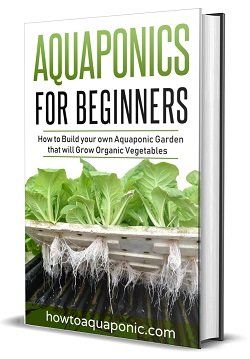Aquaponics systems, we all love them.
In this article, I’m going to give you the main aquaponics systems that are available.
These are proven to work, and many people are using them.
Do you know how Aquaponics works? If not, read my article: What is Aquaponics.
First, let’s talk about which systems are good for the home grower and then which systems are suitable for commercial or bigger aquaponics systems.
Home Aquaponics Systems
Aquaponics systems that you can build at home are referred to as home aquaponic systems.
These include:
- The media bed
- NFT channels
- Vertical towers or A-frames
- Dutch Buckets
- Deep flow technique
Commercial Aquaponics Systems

Commercial aquaponics systems mainly consist of deep water culture or simply, DWC.
They are styrofoam rafts that float on a body of water and can be handled easily for smooth operation.
Overview of Common Aquaponic Systems
Media Bed or Growbed
The media filled bed or flood and drain system is by far the most used aquaponics system. This system is used by backyard gardeners because it’s quite easy to understand and get started.
The water from the fish tank gets lifted with a solids lifting overflow to a filter where the first settable solids will be separated out. This is necessary if you use a large amount of fish. If you use small fish or a low stocking density you can pump the water straight to the growbeds.
Once the water is in the growbeds the level will start to rise, a siphon will drain the water back to the sump or fish tank. A media bed can be made with different media.
Read more about grow-media and growbeds in my article: Aquaponics Growbed
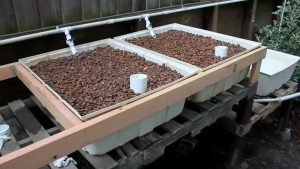
The fine solids that your filter didn’t catch will end up in the growbed. Bacteria and red worms will break the solids down and mineralize them for you which will increase nutrient availability.
You can plant about anything in the growbeds, just make sure it doesn’t get clogged with solids. A media-filled bed is highly susceptible to denitrification which means that the nitrifying bacteria in your growbed will die because of zones that are rotting.
Advantages
- Acts as mineralization
- Captures fine solids
- Acts as bio-media
Disadvantages
- Most of the times, a sump is needed
- Clogging of the growbed is possible
- Growbeds are heavy, need strong support
- Highest maintenance method, not suitable for commercial systems
Nutrient Film Technique or NFT
The nutrient film technique or simply NFT uses gutter pipes to create a small film of nutrient water to the roots.
This technique is popular in hydroponics.
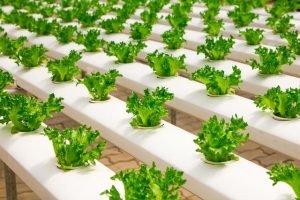
The gutters have a flat bottom in commercial systems to help with water flow. In backyard and DIY setups, the gutters are round because people use 3-4 inch PVC pipes with 2-inch net cups. The round piping makes water flow more difficult. You have to make sure solids filtration is good and there is no clogging of the pipes.
It is used in backyard systems as a way to save space. The most common use of these are vertical A-frames.
Read more about the Nutrient Film Technique in my article: NFT aquaponics.
Advantages
- Less water volume is needed, makes it suitable for rooftops
- A small pump is needed
Disadvantages
- Additional biofiltration
- Higher temperature fluctuations of the water
- A blockage in the channel might destroy your crop
- Only suited for small crops like lettuce
- Solid filtration needs to be good
Deep Water Culture or Floating Rafts
The deepwater culture or DWC is used in most commercial aquaponics systems. Most of these are modeled after the UVI design (University of the Virgin Islands). They set up a system that produces them tilapia and leafy vegetables. This system was proof that aquaponics can be commercially attractive if the market allows it.

The floating rafts are styrofoam boards with 2 to 3-inch net cups in them. Under the rafts is a steady and constant slow-flowing water mass that submerges the roots. Because the roots are submerged you will need to deliver extra oxygen under the rafts.
This system is good at producing small crops like lettuce, basil, okra,…
Read more about the DWC technique in my article: Floating raft aquaponics.
Advantages
- A constant flow of water in the troughs
- The temperature of the water is stable because of the large mass of the water
- Ease of use
- Most commercial farms use this technique so it has a proven track record
Disadvantages
- Solid filtration need to be good
- Aeration is needed in the hydroponic trough
- A heavy system, not suitable for rooftops
Vertical Towers
If you are tight on growing space you can use vertical towers. Most people are familiar with the zipgrow towers.
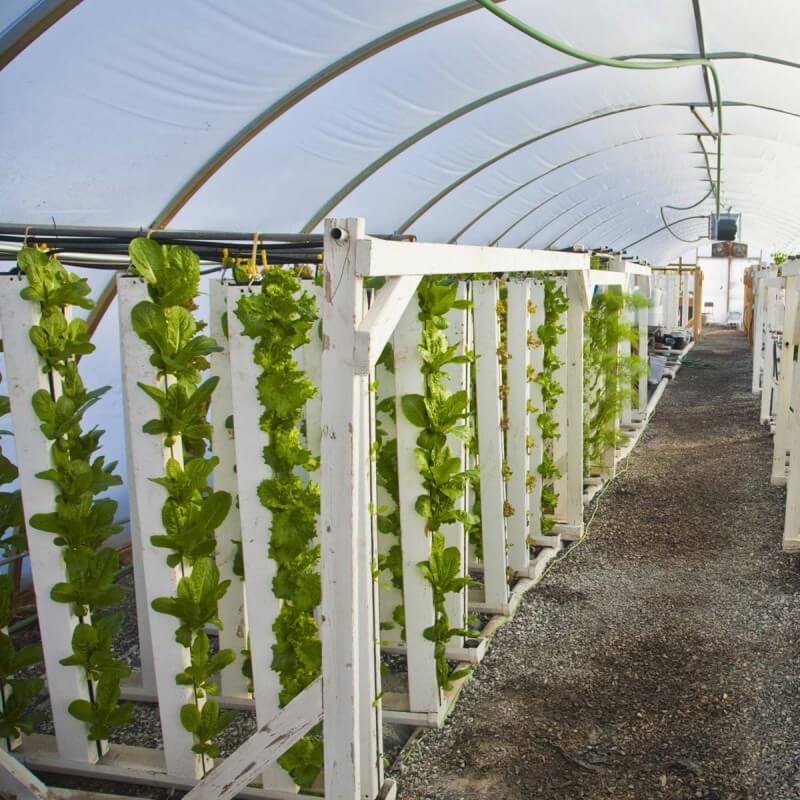
You can see it as a vertical NFT system but better.
The roots of the crops are placed in a bio media where water trickles on. The roots are supplied with nutrient-rich water while the bio media removes ammonia and nitrates from the water.
You need to make sure each tower receives enough water to make this happen. I would only advise to use this technique if you are advanced.

Read more about vertical towers in my article: Vertical Aquaponics.
Advantages
- Saves space
- Biological filtration inside of the towers
- Ergonomic
Disadvantages
- Not every plant likes to grow vertically
- Sometimes, additional lighting is needed
- Not as easy to dial in
Dutch Buckets
Dutch buckets is a drip irrigation system combined with media beds.
Dutch buckets are used to grow fruiting or big crops. They are small growbeds with a trickle of water on a timer. The bottom of the bucket has two inches of water in it to provide water to the plant.
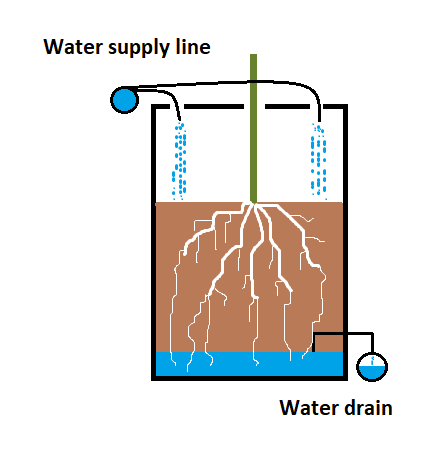
It is advised to turn on the timer three times a day for 5-10 minutes. Make sure the water is delivered close to the root mass of the plant.
The drain will return to the sump.
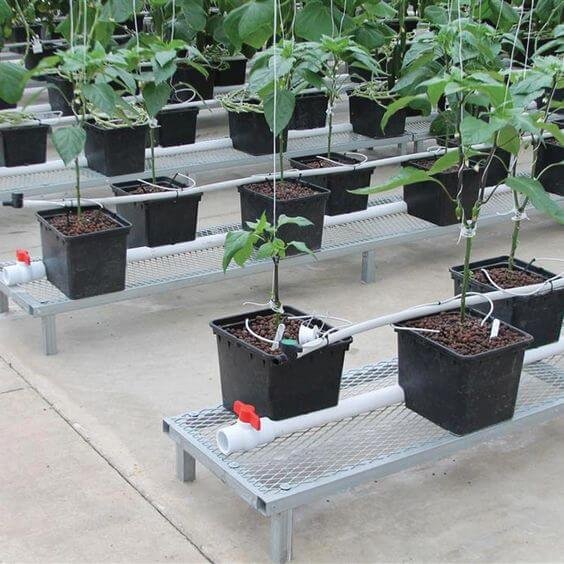
Read more about dutch buckets in my article: Dutch bucket Aquaponics.
Advantages
- A contained growing system
- Gives plants support
- Movable
- Ideal for fruiting plants
Disadvantages
- Additional biofiltration is needed
- Water might heat up quickly because of the biomass of the grow media
- Not cost-effective for vegetative crops like lettuce
- More feed input is needed to create enough nutrients for fruiting crops
Deep Flow Technique or DFT
Deep flow technique or DFT is similar to NFT but in this system, the water level is higher.
The gutter pipes are filled 50% with water, just touching the bottom of the net cup. This technique is easier for beginners because they don’t have to dial in the nutrient film that an NFT has.
Because the roots will be submerged in the water, you will have to provide oxygen to the roots just like in the deep water culture system. You do this by installing airstones in the gutter pipes where the water enters.

Advantages
- A small pump is needed
- More water in the channels makes it more error-proof
- Fewer temperature fluctuations
Disadvantages
- Additional biofiltration is needed
- A blockage in the channel might destroy your crop
- Only suited for small crops like lettuce
- Solids filtration needs to be good
- You need aeration in the channels
Wicking Beds
The last aquaponics system is the wicking bed. A wicking bed is used to grow root crops.
There are two options if you want to use a wicking bed, a recirculating or non- recirculating.
Recirculating will take the water back to the sump or fish tank to be used again. A non-recirculating system is easier but will not take the water back to the fish tank.
It is a raised bed with media in the bottom. The media will be submerged in the water all the time. Over this media, you will need to put a weed barrier. On top of this weed barrier, you need to put your wicking material. This can be composting soil, just make sure it wicks the water up to the roots of your plants.
This wicking effect will deliver nutrients to the root of the plant while you can grow potatoes, carrots or radishes.

Read more about making a wicking bed in my article: Wicking bed Aquaponics.
Advantages
- Can grow rooting crops
- Prevents evaporation
- Water efficient
- Good drainage
Disadvantages
- Additional biofiltration is needed
- Complex installation
- Not viable for commercial systems, only specialty crops

Nick loves building, managing and giving others advice on aquaponics. He created this website to do just that. He is the author of Aquaponics for beginners. If you got a question contact him here or read more on the about page here.

